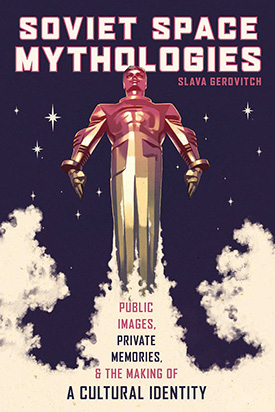Slava Gerovitch, Soviet Space Mythologies: Public Images, Private Memories, and the Making of a Cultural Identity (University of Pittsburgh Press, 2015)
Slava Gerovitch is a lecturer in history of mathematics at the Massachusetts Institute of Technology. He is the author of From Newspeak to Cyberspeak: A History of Soviet Cybernetics (2002) and Voices of the Soviet Space Program: Cosmonauts, Soldiers, and Engineers Who Took the USSR into Space (2014).
Awards
- Winner of the 2021 Gardner-Lasser Aerospace History Literature Award for the best original contribution to the field of aeronautical or astronautical non-fiction literature published in the last five years dealing with the science, technology, and/or impact of aeronautics or astronautics on society, from the American Institute of Aeronautics and Astronautics;
- Finalist for the 2016 Historia Nova Prize for the Best Book on Russian Intellectual and Cultural History. The New Literary Observer editor-in-chief Irina Prokhorova has conducted an interview with the three finalists for the Prize on the current state of intellectual history in Russian studies.
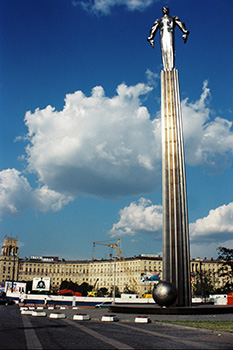
Gagarin monument in Moscow. Image courtesy of Babak Fakhamzadeh.
Endorsements
“This book makes an invaluable contribution to the myth and memory, as well as the actual fact, of the experiences of the cosmonauts in the space race era, and with it Slava Gerovitch establishes himself as a major scholar on the subject.”
—Roger D. Launius, National Air and Space Museum, Smithsonian Institution
“Gerovitch’s original history is a new synthesis in the history of Soviet spaceflight, expertly bringing together political and cultural strains with the professional identity of the astronauts and the human/machine systems in which they worked.”
——David A. Mindell, Massachusetts Institute of Technology
“Soviet Space Mythologies makes a major contribution to the history of Soviet space flight and culture. It places the story of Russian space conquest into the broader history of space flight—including references to pioneering scholars in the history of NASA.”
—Andrew Jenks, California State University, Long Beach
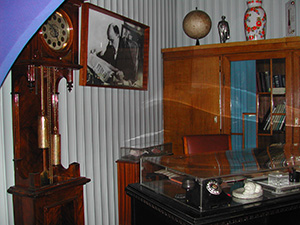
Sergei Korolev’s office memorial at the Energia Corporation Museum, 2004. Photo by author.
Reviews
“Based on prodigious research, and framed within interdisciplinary theoretical constructs, Slava Gerovitch has written a fascinating cultural history of Soviet space mythology and technology. While drawing on private diaries, published documents, and interviews with key actors in the space project, this book explores not only space myths, but also how counter-myths played a constructed role in public discourse.”
—James T. Andrews, The Russian Review
“Soviet Space Mythologies succeeds in its ambition to place the Soviet space program squarely at the center of twentieth-century Russian history, and it convincingly demonstrates the benefits of using the study of technology as a means to understand broader social and political dynamics. ... Gerovitch thus provides another meaning for the Soviet space program: that of a microcosm for Bolshevism as a failed intellectual project, hamstrung by its conceptual shortcomings.”
—Stephen Brain, Journal of Modern History
“The topics include the construction of Soviet and post-Soviet space history myths, images, and propaganda; competing visions of spaceflight and the appropriate role of cosmonauts; and the construction of professional, personal, and public identity by engineers, cosmonauts, and other space personnel. The chapter on Yuri Gagarin’s flight embeds these topics in a stimulating collection of official documents, interviews, recollections, and other unofficial materials that create a faceted but coherent picture of the social and political environment in which Chief Designer Sergei Korolev sent the first human into space.”
—Jonathan Coopersmith, Isis: A Journal of the History of Science Society
“With Soviet Space Mythologies, Slava Gerovitch has given us a vitally important and beautifully written contribution to the growing historiography on the Space Race. As with his first monograph, From Newspeak to Cyberspeak (2002), Gerovitch masterfully mixes methods from the history of science and technology with cultural history.”
—Joshua First, Technology and Culture
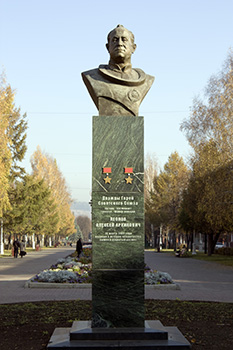
Monument to cosmonaut Aleksei Leonov in Kemerovo. Image courtesy of Egor Fidirko.
“This very readable book provides a new insight into the Soviet space programme and the way in which it has been presented to the world, both at the time and subsequently. As with so much in the USSR, the space programme was shaped for propaganda purposes, with failures painted quietly out of history. The book is not so much a straightforward factual account of Soviet achievements in space (that can be found elsewhere) but a study of image and the manipulation of collective memory.”
—Christopher Hollings, British Journal for the History of Science
“Gerovitch competently, confidently and convincingly traces the mutation of the Soviet space mythology into the post-Soviet one. In the atmosphere of post-ideology and post-truth, space mythology has acquired a new lease of life, uniting a fragmented Russian society with the distorted memories of the glorious early days of the space race.”
—Andrei Rogatchevski, European History Quarterly
“This book is a fascinating history of the triumphs and failures of the soviet space programme in the 1960s, portraying vividly its leading figures—cosmonauts, engineers and military personnel—caught in the identity split between professional roles and public personas, and positioning them within the complicated technological and institutional settings of Soviet cosmonautics.”
—Elitsa Stanoeva, Europe-Asia Studies
“The value of this book lies in its analysis of the relationship between a cultural identity with space achievements and the ordinary citizen outside the space community, while demonstrating the importance of establishing a connection to the driven purpose of the state machinery, in reality an example every bit as fitting in the West as in the East.”
—David Shayler, Spaceflight
“Focusing on the cosmonauts and engineers who were the human forces behind and representatives of a program shrouded in secrecy, the book engages the ironies of the identity crises that defined and still inform the cultural memory of the glory days of the manned spaceflight program.”
—Amy Nelson, Slavic Review
“Soviet Space Mythologies reflects on every page the well-known precision and thought-provoking work of the author. All articles in the volume are not limited to space history but engage with a number of larger critical issues surrounding the study of the often paradoxical nature of the Soviet experience.”
—Julia Richers, Kritika: Explorations in Russian and Eurasian History
“Soviet Space Mythologies approaches the history of the Soviet space program using a combination of cultural history and memory studies. Memory, in Gerovitch’s analysis, is both a private and public affair. Interpretations and representations of the past help to fashion both selves and social identities.”
—Matthew Shindell, Quest: The History of Spaceflight Quarterly
“Through a skillful use of post-Soviet cultural markers such as the novel Omon Ra by Victor Pelevin, movies, and documentaries, Gerovitch argues that the heroic cosmonaut archetype now has been embedded into the nostalgia many Russians have for an imagined past of greatness, now unencumbered by moral or narrative ambiguity.”
— Asif Siddiqi, The Soviet and Post-Soviet Review
“In terms of history of science, Gerovitch’s great merit lies in the fact that for the first time he dealt with the relationship between man and machine in depth, which had multiple implications for the control of spaceships, the role of cosmonauts and the conceptualization of the further development of manned space travel. ... Soviet Space Mythologies will undoubtedly become an indispensable reading for the study of Soviet space history.”
—Matthias Schwartz, H-Soz-Kult (in German)
“It is an important achievement to present the power and potential of myths for the cohesion of each collective in relation to history as convincingly as Gerovitch did. The book is an indispensable and outstandingly well written reading material not only for specialists in the cultural history of the Soviet Union after Stalin, but also for those who are interested in collective memory and memory practices.”
—Jan Tesař, Jahrbücher für Geschichte Osteuropas (in German)
“Soviet Space Mythologies is a major contribution to the history of the Soviet Union and space. Its contribution is also due to the socio-cultural approach that the book takes: by detaching the immediate attention from strictly political or organisational aspects, it opens many questions on the relationship between professions and the State, and ultimately proposes a very stimulating reflection on science and technology policy.”
—Isabelle Gouarné, Humanités spatiales (in French)
“Slava Gerovitch has written an important book where the clarity of analysis is combined with a powerful and poignant story. ... Gerovitch brings to light the complexity of issues and provides understanding of the evolution of the space program in its continuities and breaks. ...if public "myths" were used to embody abstract ideological concepts and to bring cohesion to the social body, “counter-myths” reinforced the professional identity of engineers and cosmonauts.”
—Grégory Dufaud, Cahiers du Monde russe (in French)
From the start, the Soviet human space program had an identity crisis. Were cosmonauts heroic pilots steering their craft through the dangers of space, or were they mere passengers riding safely aboard fully automated machines? Tensions between Soviet cosmonauts and space engineers were reflected not only in the internal development of the space program but also in Soviet propaganda that wavered between praising daring heroes and flawless technologies.
Soviet Space Mythologies explores the history of the Soviet human space program within a political and cultural context, giving particular attention to the two professional groups—space engineers and cosmonauts—who secretly built and publicly represented the program. This book shows how both the myths of Soviet official history and privately circulating counter-myths have served as instruments of collective memory and professional identity.
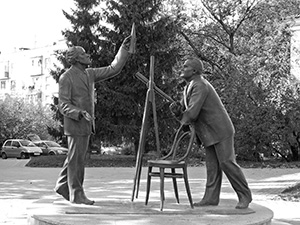
Monument dedicated to Sergei Korolev’s alleged 1929 visit to Konstantin Tsiolkovskii in Kaluga. Image courtesy of Boris Mavlyutov.
Introduction. Creating Memories of the Space Age (PDF)
Chapter 1. “Why Are We Telling Lies?”: The Construction of Soviet Space History Myths
Chapter 1 explores the formation of key myths of the Soviet space age, such as the Korolev myth and the cosmonaut myth, focusing on memoirs and commemorative events as cultural vehicles for mythologization of history. Rather than seeing Soviet space myths as pure propaganda tools, this chapter examines them as a function of Soviet remembrance practices, both public and private.
- Three Photographs and Three Types of Studies
- Myths and Counter-Myths
- The Space Age in American Culture
- Russian Space Memorialization
- Mythologizing Cosmonauts
- Mythologizing Engineers
- Counter-Memories of the Soviet Space Program
Chapter 2. Stalin’s Rocket Designers’ Leap into Spacе: The Technical Intelligentsia Faces the Thaw
Chapter 2 examines the impact of the professional culture of rocket engineering in late Stalinism on the engineering and organizational practices of the space program during the Khrushchev era. Focusing on such notions as control, authority, and responsibility, this chapter examines the role of engineering culture in shaping the Soviet approach to the automation of piloted spacecraft control.
- Organizational Problems of the Rocket and Space Industry
- Playing the System
- A Tiny Screw in a Giant Mechanism
- Dual Use, Dual Identity
- Elite Engineers: Between Autonomy and Loyalty
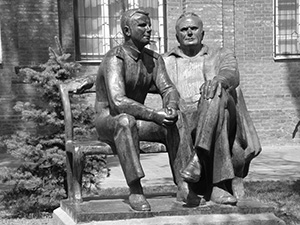
Monument to Korolev and Gagarin in Taganrog. Image courtesy of Anatolii Karpika.
Chapter 3. "New Soviet Man” inside Machine: Human Engineering, Spacecraft Design, and the Construction of Communism
The Soviet cosmonauts publicly represented a communist ideal, an active human agency of sociopolitical and economic change. At the same time, space engineers and psychologists viewed human operators as integral parts of a complex technological system and assigned the cosmonauts a very limited role in spacecraft control. This chapter examines how the cosmonaut self became the subject of “human engineering” and draws parallels between the iconic roles of the cosmonaut and the astronaut in the Cold War context.
- “A Flaming Motor for a Heart”: New Soviet Man in the Sky
- From Stalin’s “Falcons” to Korolev’s “Little Eagles”
- Human Engineering and the Design of a Cosmonaut
- Operator Training: Toward a Perfect Automaton
- Psychological Training: Toward Total Self-Control
- Paradox of Disciplined Initiative
- New Soviet Man Meets American Hero
Chapter 4. The Human in the Arms of Technology: Gagarin’s Flight in Documents and Stories
Chapter 4 interweaves documents and stories about Gagarin’s pioneering spaceflight. The official narrative of Gagarin’s mission became a success story, and all the details that complicated the picture were purged from the record. Through memoirs, diaries, and documents, this chapter gives voice to conflicting accounts by many participants and observers, creating a multifaceted picture of myth in the making.
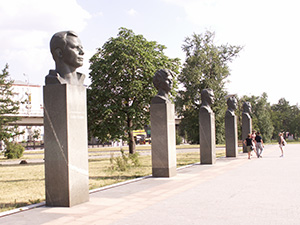
Cosmonauts Alley in Moscow. Image courtesy of Aleksandr Litvak.
Chapter 5. Human-Machine Issues, the Cosmonaut Profession, and Competing Visions of Spaceflight
Chapter 5 focuses on the seemingly technical debates over the proper degree of automation of spacecraft control. These disputes were crucial to the definition of cosmonauts’ requisite skills as either pilots or engineers. Here technology, professional identity, and social status became closely intertwined. The issue of onboard automation also raised larger questions of the meaning and purpose of human spaceflight.
- Automation on Vostok: Technological, Disciplinary, and Medical Factors
- Vostok Dual Use: Military/Civilian and Automatic/Manual
- The Voskhod 2 Mission: The Cosmonaut Takes Control
- Designing a Cosmonaut for Soyuz
- Soyuz Flights: Dividing Glory and Responsibility between Human and Machine
- The Role of Ground Control
- The Lunar Program: A Forced Turn toward Manual Control
- Defining the Cosmonaut Profession
- Automation in Context
- Astronauts and Cosmonauts: The Same Profession?
Chapter 6. The Human inside a Propaganda Machine: The Public Image and Professional Identity of Soviet Cosmonauts
Chapter 6 is devoted to the tension between the public image and professional identity of Soviet cosmonauts. All the questions that most interested the cosmonauts—the technological aspects of spaceflight, the emergencies in orbit, and plans for future flights—had to be left out of their public speeches. The cosmonauts were forced to follow the preset agenda of the space propaganda machine, just as they had to fit into the automated control system of their spacecraft. Just as they tried to broaden their control over spacecraft, the cosmonauts tried to gain greater control over their social role.
- The Making of a Living Symbol
- The Burden of Fame
- The Human Side of a Public Icon
- Cosmonauts Speak Out
- The Decline of the Cosmonaut Myth
- The Stakhanovites in Space
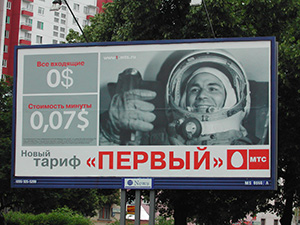
A billboard advertisement in Moscow, June 2006. Photo by author.
Chapter 7. Remembering the Soviet Space Age: Myth and Identity in Post-Soviet Culture
Chapter 7 focuses on the interplay of myth and identity in post-Soviet culture. In today’s Russia, which has lost its former communist ideals and is still searching for a unifying “national idea,” Gagarin’s pioneering flight—the pinnacle of the Soviet space program—often stands as a symbol of history that the Russians could really be proud of, despite the trauma of losing the superpower status. In post-Soviet Russia the cultural heritage of the decades of the Communist rule oddly combines with the newly developing capitalist culture, as advertising campaigns often skillfully combine old Soviet symbolism with “new Russian” capitalist values.
- The End of the Soviet Union and the Collapse of the Master Narrative
- The Nostalgic Poetics of Post-Soviet Space Memory
- Russian Capitalism and the Semiotics of Space
Booksellers
